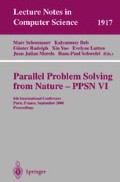Abstract
A conceptual objective behind the self-adaptation of the mutation distribution is to achieve invariance against certain transformations of the search space. In this paper, a priori invariances of a simple evolution strategy and invariances, which can be introduced by self-adaptation, are identified. In principle, correlated mutations can achieve invariance against any linear transformation of the search space. Correlated mutations, as typically implemented, are investigated with respect to both a priori and new invariances. Simulations reveal that neither all a priori invariances are retained, nor the invariance against linear transformation is achieved.
Access this chapter
Tax calculation will be finalised at checkout
Purchases are for personal use only
Preview
Unable to display preview. Download preview PDF.
References
Thomas Bäck, Uwe Hammel, and Hans-Paul Schwefel. Evolutionary computation: Comments on the history and current state. IEEE Transactions on Evolutionary Computation, 1(1):3–17, 1997.
Thomas Bäck and Hans-Paul Schwefel. An overview of evolutionary algorithms for parameter optimization. Evolutionary Computation, 1(1):1–23, 1993.
Nikolaus Hansen. Verallgemeinerte individuelle Schrittweitenregelung in der Evolutionsstrategic Eine Untersuchung zur entstochastisierten, koordinatensystemunab-hängigen Adaptation der Mutationsverteilung. Mensch und Buch Verlag, Berlin, 1998. ISBN 3-933346-29-0.
Nikolaus Hansen and Andreas Ostermeier. Adapting arbitrary normal mutation distributions in evolution strategies: The covariance matrix adaptation. In Proceedings of the 1996 IEEE International Conference on Evolutionary Computation, pages 312–317, 1996.
Nikolaus Hansen and Andreas Ostermeier. Completely derandomized self-adaptation in evolution strategies. Evolutionary Computation, 2000. To appear.
Nikolaus Hansen, Andreas Ostermeier, and Andreas Gawelczyk. On the adaptation of arbitrary normal mutation distributions in evolution strategies: The generating set adaptation. In L. Eshelman, editor, Proceedings of the Sixth International Conference on Genetic Algorithms, pages 57–64, Pittsburgh, 1995. Morgan Kaufmann, San Fransisco.
Christian Holzheuer. Analyse der Adaptation von Verteilungsparametern in der Evolutionsstrategie. Diploma thesis, Fachgebiet Bionik und Evolutionstechnik der Technischen Universität Berlin, 1996.
Zbigniew Michalewicz. Genetic Algorithms + Data Structures = Evolution Programs. Springer-Verlag, Berlin Heidelberg New York, 1996. Third edition.
Ingo Rechenberg. Evolutionsstrategie’ 94. frommann-holzboog, Stuttgart, 1994.
Günter Rudolph. On correlated mutations in evolution strategies. In R. Manner and B. Manderick, editors, Parallel Problem Solving from Nature, 2, Proceedings, pages 105–114, Brüssel, 1992. North-Holland.
Ralf Salomon. Reevaluating genetic algorithm performance under coordinate rotation of benchmark functions. BioSystems, 39(3):263–278, 1996.
Hans-Paul Schwefel. Numerical Optimization of Computer Models. Wiley, Chichester, 1981.
Hans-Paul Schwefel. Evolution and Optimum Seeking. Sixth-Generation Computer Technology Series. John Wiley & Sons Inc., New York, 1995.
Patrick D. Surry and Nicholas J. Radcliffe. Formal algorithms + formal representations = search strategies. In H.-M. Voigt, W. Ebeling, I. Rechenberg, and H.-P. Schwefel, editors, Parallel Problem Solving from Nature—PPSN IV, Proceedings, pages 366–375, Berlin, 1996. Springer, Berlin.
D. Whitley, K. Mathias, S. Rana, and J. Dzubera. Evaluating evolutionary algorithms. Artificial Intelligence, 85:245–276, 1996.
Author information
Authors and Affiliations
Editor information
Editors and Affiliations
Rights and permissions
Copyright information
© 2000 Springer-Verlag Berlin Heidelberg
About this paper
Cite this paper
Hansen, N. (2000). Invariance, Self-Adaptation and Correlated Mutations in Evolution Strategies. In: Schoenauer, M., et al. Parallel Problem Solving from Nature PPSN VI. PPSN 2000. Lecture Notes in Computer Science, vol 1917. Springer, Berlin, Heidelberg. https://doi.org/10.1007/3-540-45356-3_35
Download citation
DOI: https://doi.org/10.1007/3-540-45356-3_35
Publisher Name: Springer, Berlin, Heidelberg
Print ISBN: 978-3-540-41056-0
Online ISBN: 978-3-540-45356-7
eBook Packages: Springer Book Archive

